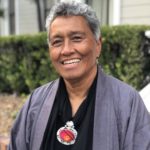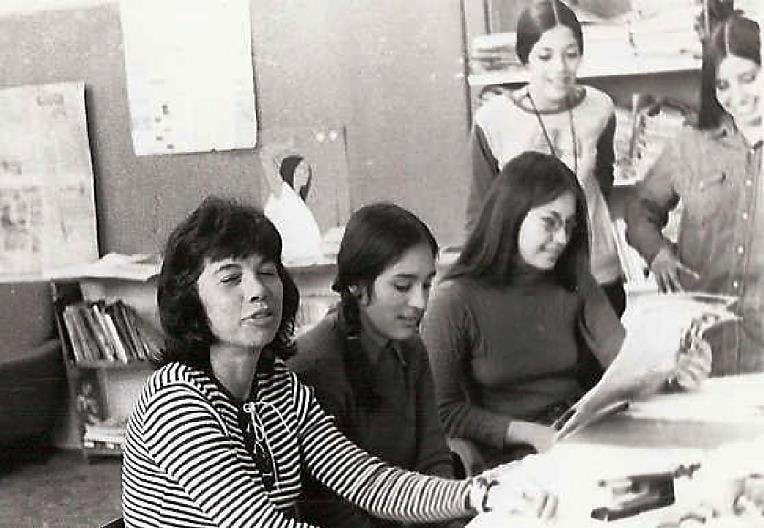With deep sadness and respect, Organizing Upgrade is sharing a few more tributes to movement elder Betita Martinez, who died June 29. In her 95 years she lived many lifetimes, and brought her commitment, wit and political clarity to several of the most significant social movements of our day. This is the second and last set of reflections on her and her work. Our first reflections come from Cindy Wiesner and Amy Sonnie.
Elizabeth “Betita” Sutherland Martinez grew up in the suburbs of Washington, D.C. After college she moved to New York City, where she worked for the United Nations and then immersed herself in the literary scene as an editor and writer. In 1965, when she was 40, she became the director of SNCC’s New York office, plunging into the full-time activism that would define the rest of her life.
When SNCC turned towards all-Black leadership in 1967, Betita first explored radical feminism, then a largely white space. A year later she moved to New Mexico to learn about the land rights struggle led by Reies Lopez Tijerina. There she co-founded the newspaper El Grito del Norte (Cry of the North) and the Chicano Communications Center, a Marxist collective. When the collective fell apart in 1974, Betita moved to San Francisco and worked for 10 years with the Democratic Workers Party. After the party dissolved, she continued her work as an organizer, writer, and teacher. She founded the Institute for MultiRacial Justice, helped launch the publications CrossRoads and War Times, taught and lectured and published more than 100 articles. Among her several books, 500 Years of Chicano History in Pictures and 500 Years of Chicana Women’s History are probably the best known.
In “The Work Said Who I Was,” Betita’s longtime comrade Tony Platt offers an eloquent capsule biography, which we drew on for this introduction.
Betita: Embracing Complexity and Contradiction
By Margo Okazawa-Rey
Betita was my movement teacher, comrade, and friend. We began as board members of the Women of Color Resource Center, later worked together in the Institute for MultiRacial Justice that she founded. And we lived close by—she on 24th Street and I on 30th in San Francisco.
Two things come to me when I think of Betita. First are the themes that emerge when you read official obituaries in major news sources in the U.S. and elsewhere, and the remembrances, testimonies and messages from former students, friends, comrades in the struggle, and even from those who never knew her but only read her works or listened to her speaking somewhere. Betita was courageous, ready to enter and engage in unknown, often dangerous intellectual and social arenas – even to create paths where no one could even imagine them. It was not easy to challenge the dominant Black-white U.S. racial paradigm and history and implore, demand, that the frame be adjusted to give a more accurate picture of the colonial, racial, and capitalist beginnings and current realities of the U.S. 500 Years of Chicano History, and later, 500 Years of Chicana Women’s History, brought that point to my intellectual and political “home.” I could no longer accept the dominant view thereafter.
The other is that Betita was a complex and complicated human being. As friend and movement leader Cindy Wiesner described her in a conversation we had some days ago: “Betita was courageous, audacious, stuck to her guns, was never afraid to be the first, all the while dressed to the nines in her gold lamé, white boots, red lipstick.” Absolutely consistent in her political principles that challenged patriarchy, racism, imperialism, capitalism, all the isms, she was herself, and loved what she loved. And she had flair! Betita also was accompanied by another being she loved. Xochitl, the black and white dog (who knows how old) who acted like a puppy all the times I encountered her. With her is when I observed Betita being very tender.
One of the most important lessons I learned from Betita is to name, understand, and embrace complexity and contradictions. I saw this most closely when I was involved in helping get the Institute for MultiRacial Justice off the ground. We were a multi-racial, multi-generational group. Working with Betita were grad students, academics, activists, all bringing our experiences and knowledge (heavy on theory sometimes); some bringing wisdom; some being patient. All of us were curious and committed. As with many of our social-change efforts that are not self-centered and are about the work needing to be done, we had little idea how far ahead of our time we were. We just did what we thought needed doing.
Betita as our leader was a complex mix of patience and impatience, of curious and knowing the answers already. I am sure she also thought the same about the rest of us at times. In the end, we were able to move closer to our ideals organizationally and to our vision of multi-racial justice through our newsletter, Shades of Power, and other projects. The most important lessons for me: never be afraid to be among the first, keep practicing intersectionality because I live it and see it everywhere, be audacious, do things and be a person with flair. Anti-imperial, anticolonial, anti-racist, socialist, intersectional feminist with FLAIR!
Betita: may you rest in power and love!
 Margo Okazawa-Rey, Professor Emerita at San Francisco State University, is an activist and educator working on issues of militarism, armed conflict and violence against women. She is the author of ’Nation-izing’ Coalition and Solidarity Politics for US Anti-militarist Feminists (2020); co-editor of Gendered Lives: Intersectional Perspectives (2020) and Activist Scholarship: Antiracism, Feminism and Social Change (2009). She was Professor of Leadership Studies at Fielding Graduate University and the Elihu Root Peace Fund Visiting Professor in Women’s Studies at Hamilton College. She is a founding member of the Combahee River Collective.
Margo Okazawa-Rey, Professor Emerita at San Francisco State University, is an activist and educator working on issues of militarism, armed conflict and violence against women. She is the author of ’Nation-izing’ Coalition and Solidarity Politics for US Anti-militarist Feminists (2020); co-editor of Gendered Lives: Intersectional Perspectives (2020) and Activist Scholarship: Antiracism, Feminism and Social Change (2009). She was Professor of Leadership Studies at Fielding Graduate University and the Elihu Root Peace Fund Visiting Professor in Women’s Studies at Hamilton College. She is a founding member of the Combahee River Collective.
Inimitable, Indefatigable, Irrepressible
Interview with Elizabeth “Betita” Martinez, by the Women of Color Resource Center
This interview was originally published in the Summer/Fall 1999 issue of “Sister 2 Sister,” the newsletter of the Women of Color Resource Center. Thanks to Linda Burnham for sharing it. Betita served on the Center’s board in the 1990s and 2000s.
Women of Color Resource Center: In your book you talk about Chicanisma as a kind of feminism that bridges anti-racist and anti-sexist struggles. What do you see as the most hopeful signs in the development of Chicanisma, and what are the most discouraging?
Elizabeth Martinez: I think the most hopeful sign has been the total difference between the 1990s and the ‘60s in terms of the role of Chicanas as activists. Remembering back to the ‘60s when I was in the movimiento in New Mexico, I have a lot of recollections of sexist policies and practices, to the point where a man in leadership in a major group was beating his girlfriend, and nobody challenged him about that. Within the movement roles were assigned to women based on traditional definitions of “appropriate women’s work.” I don’t think I ever saw a man make coffee, or type up the minutes, or that kind of thing. There were rare exceptions, but the rule was a very gendered division of labor.
Today the participation of women is so different. I’ve seen young Chicanas doing security, making speeches and planning strategy. For example, in the hunger strike at UC Berkeley this year the leadership was overwhelmingly female. Two of the main negotiators with the chancellor were Chicanas and nobody questioned their leadership. Even in private life things are quite different.
There was a time when a girl would be told by her mother to make her brother’s bed. He would not wash the dishes either. That was considered normal. It’s not anymore. The flip side is that there are some signs of backlash with people coming up today not knowing there ever was a struggle against sexism. I think that there’s some feeling of, “These women, now that they’ve made it, what are they complaining about.” Young guys are coming up who are not so aware of the struggles and not so willing to go along, because they feel threatened. The male feeling of being threatened is still strong, not just with Chicanos and Latinos.
WCRC: In your book [De Colores Means All of Us – Latina Views for a Multi-Colored Century] you emphasize the role that women like Cherríe Moraga and Gloria Anzaldúa have played in developing Chicana feminism. Would you talk a little bit more about how the struggle against homophobia moves all women’s issues forward?
EM: I’m so glad you mentioned that because there’s less progress against homophobia than against sexism among Chicano and Chicana activists. That’s worth noting. It’s striking. You can talk about it, a person can be gay or lesbian without being absolutely ruled out from any leadership role, unlike in the 1960s and ‘70s, and there will be corrections of expressions of homophobic attitudes in group situations. So there’s some progress there, but not enough. In terms of why the emergence of lesbianism helped the women’s movement overall, I think it’s probably because it shook up the dominant gendered view in a very profound way, and that triggered a lot more feminist consciousness. I find them inseparable. I think that homophobia is very much rooted in the same patriarchal structure that oppresses women, the same way of defining make and female roles. To challenge it, as Cherríe Moraga and Gloria Anzaldúa and others did, was to challenge the whole definition of women.
WCRC: Many of the essays in your book focus on tensions within the progressive movement. What do you see as some of the main challenges that Chicanas currently face in the society as a whole, and are there hopeful signs of organizing to meet those challenges?
EM: There’s a long tradition of Chicana and Latina women organizing as workers. In the cotton fields, in the garment factories women have challenged exploitation because they’ve been out there working, contrary to any image of the little housewife at home making frijoles. With the ever-increasing immigration and migration of Latina workers, they are in some of the most exploited positions. For example, in Oxnard, CA there was a Nabisco factory where women workers, mainly Mexicana and Chicana, were not allowed to go to the bathroom. They were told to wear diapers. That did not happen to the men. A successful suit was filed against the plant. I’m giving this as an example of particularly demeaning exploitative treatment. There are all sorts of ways in which exploitation as workers, who have some of the lowest paid jobs in the economy, and oppression as women combine to create situations where women have all the more cause to rise up and organize.
In terms of students and youth, there are other issues. They face the ending of affirmative action and bi-lingual education and the relentless undermining of ethnic studies. I’m constantly hearing of new examples of the attacks on ethnic studies. Ethnic studies and Chicana/o cultural centers are places where young Chicanas and other Latinas have been able to develop their skills, their intellectual abilities and their leadership abilities in a less racist environment. It’s important for people to understand that it’s not just another department. It has a particular function to challenge the paradigm of dominance and that has its special place for women.
WCRC: How do you see your life-long concern with Chicana/o issues relating to your current work at the Institute for MultiRacial Justice?
EM: This goes back a long way to when I was working full-time for the Student Non-Violent Coordinating Committee, first as a volunteer and then from 1964 to ’67 as one of two Chicanas on staff. I was living in the East then, and if you wanted to fight racism and struggle for social justice you worked with the Black Civil Rights Movement. Having grown up aware that there was “something wrong” with being Mexican, it seemed very natural to gravitate towards working in that movement. Going back to that time I have really wanted to see peoples coming together. For many years that meant primarily Black and Brown folks. Now of course it also means Asians and Arab Americans, Pacific Islanders and Native Americans. That’s always been my little dream – big dream, too big sometimes. The Institute was started out of a recognition that the 21st century was likely to see more division – encouraged division – among people as the demographics shift to a white minority society. The bridges that I wanted to help build were going to be harder than ever but maybe also more necessary than ever. One of the main things from the beginning is the importance of the role of women. We can joke about it and say we just have less testosterone, but women tend to be more cooperative and have taken the lead in alliance building. The whole idea is to build a stronger movement against white supremacy. We’re concentrating on people of color simply because there are particular divisions among us. It doesn’t mean that we think that white folks are not a crucial part of the equation. If we’re ever going to tear down this incredibly stubborn racism that structures our society, it’s only going to be if we join forces. That’s my personal definition of multi-culturalism – it’s about building a strong force to transform society.
 The Women of Color Resource Center (WCRC), active in the San Francisco Bay Area from 1990-2011, promoted the political, economic, social and cultural well-being of women and girls of color in the United States. Informed by a social justice perspective that took into account the status of women internationally, WCRC was committed to organizing and educating women of color across lines of race, ethnicity, religion, nationality, class, sexual orientation, physical ability and age.
The Women of Color Resource Center (WCRC), active in the San Francisco Bay Area from 1990-2011, promoted the political, economic, social and cultural well-being of women and girls of color in the United States. Informed by a social justice perspective that took into account the status of women internationally, WCRC was committed to organizing and educating women of color across lines of race, ethnicity, religion, nationality, class, sexual orientation, physical ability and age.
Betita Carved Out a Special Place in Northern New Mexico
By Adelita Medina
I just want to add my words of homage to those being expressed by hundreds of others around the country who were touched in a personal way by the life and activism of Elizabeth “Betita” Martinez.
As we have read in recent days, no matter what city or town or part of the country Betita lived in, she made special contributions and created life-long memories. One of her greatest assets was her ability to inspire and mentor young people. Here in New Mexico she passed on her knowledge and skills to scores of jovenes in the Movimiento Chicano.
Betita will always have a special place in Northern New Mexico, especially in Española and Las Vegas, where she spent several years working with El Grito del Norte and other organizations that were part of the Movimiento in the 1960s and ’70s.
I was fortunate to be introduced to her and others at El Grito in 1971 when the paper was being published out of my hometown of Española. My younger brother Luis (QPD) hung around with Betita’s daughter Tessa and her friends—Fat Joe, Elaine, and Ted—and recruited me to do proofreading at the paper that year. I had just recently become politicized as a student at New Mexico Highlands University, in Las Vegas, which became a hotbed of Chicano activism in the’70s.
My brother took me to El Grito one afternoon to do proofreading and I never left, until the paper closed down in 1973.
I am eternally grateful for the many lessons Betita taught me—about journalism, social justice, love for our people, and the importance of solidarity with struggles around our country and the world. She also insisted that we show respect for the elders and other people who lived in the communities that El Grito served. She said working on each issue to the best of our ability, making sure there were no errors, was a way of expressing our respect.
Under her tutelage, I and several other young Chicanx activists including Sandra Solis, David Montoya, and Fred Trujillo, tried our hand at writing articles about various struggles within the Movimiento, about our Native brothers and sisters, and other causes. She was an internationalist at heart, and found connections between all the struggles against oppression. She instilled that knowledge in us. One issue dedicated to Latin America required several of us to research the histories of countries we had never heard about, like Puerto Rico. We learned how to write, edit, create headlines, do layout and pasteup, take and later develop photos in the darkroom, and sort the papers for mailing by zip code.
Thanks to these invaluable hands-on experiences, I later became the editor of the school newspaper at Highlands University, co-editor of El Gallo at the Crusade for Justice, started our own paper—Tierra y Libertad—at Escuela Antonio Jose Martinez in Montezuma, and earned an MS in Journalism at the Columbia University Graduate School of Journalism.
¡Que Viva Betita Martinez!
 Over a span of 50 years, Adelita Michelle Medina has been active in multiple movements and causes—Chicano, Puerto Rican independence, anti-war, women’s rights, civil and constitutional rights, and farmworker women’s rights. She has been a journalist for movement publications, and a freelance writer. As a grant proposal writer, she has helped to raise millions of dollars for non-profit organizations in New Mexico, California, and New York. She is also a mixed-media artist.
Over a span of 50 years, Adelita Michelle Medina has been active in multiple movements and causes—Chicano, Puerto Rican independence, anti-war, women’s rights, civil and constitutional rights, and farmworker women’s rights. She has been a journalist for movement publications, and a freelance writer. As a grant proposal writer, she has helped to raise millions of dollars for non-profit organizations in New Mexico, California, and New York. She is also a mixed-media artist.


